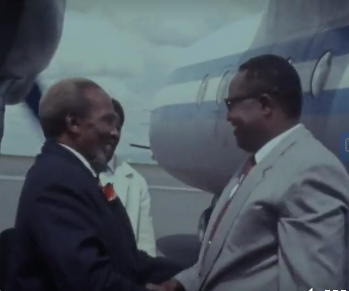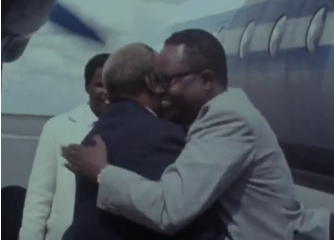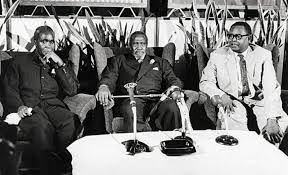Ayrotv.com- In implementation of the agreement reached between the Governments of Kenya and Somalia at the fifth
Assembly of Heads of State and Government of the Organization of African Unity held in Kinshasa on
Sept. 11–14 [see 22281 A], a memorandum of agreement was signed in Arusha (Tanzania) on Oct. 28 by
President Kenyatta of Kenya and Mr. Mohammed Ibrahim Egal, the Prime Minister of Somalia.
The two leaders, meeting under the auspices of the O.A.U. with President Kaunda of Zambia acting as
mediator, agreed to end the border fighting and to restore normal relations between their two countries. In
particular the agreement provided for the gradual suspension of emergency regulations on both sides; the
cessation of hostile propaganda; and the establishment of a committee comprising representatives of
Kenya, Somalia, and Zambia, who would supervise the implementation of the agreement and seek
satisfactory solutions of the differences between the two countries.

President Kaunda said after the meeting that he hoped that the agreement would show that Africans were
capable of solving their own problems without resorting to the use of international institutions influenced
by the very Powers who were “to blame for the mess in Africa today.”
During the months preceding the agreement heavy fighting had continued in the border areas between
Kenya and Somalia.
On March 7 the Somali Information Service claimed that 24 Kenyan soldiers had been killed and 19
wounded in two engagements the previous week, while three Somali nationalists and four Somali soldiers
were said to have lost their lives; it denied Kenyan reports that 27 members of the “National Liberation
Front” had been killed, alleging that these casualties had been Somali women and children.
On May 8 the Kenyan Ministry of Defence announced that 19 shifta raiders had been killed in the previous
week, while several of their leaders had surrendered. On May 14 a further 32 shiftas were reported killed
and many wounded during the preceding week. The Kenya Government denied on May 24 a statement by
the Somali Minister of Defence that 18 civilians had been murdered by Kenyan forces inside Somalia. On
Aug. 18 the Kenyan Ministry of Defence announced the death of 43 shiftas and three soldiers in a clash
with more than 800 shiftas at Rhamu, about 30 miles inside Kenya from the Somali border.

Dr. Njoroge Mungai, the Kenyan Minister of Defence, issued a statement on April 20 blaming again the
“expansionist aims and aggression of Somalia” for a “terrible toll of human life”; he claimed that twice
recently Kenya’s border had been violated, and that since hostilities had begun Kenya’s security forces had
“accounted for” 3,000 shiftas, of whom 1,200 had been killed. On May 2 the Kenya Government declared,
however, that it would discuss the reopening of normal relations with Somalia as soon as Somalia
renounced all claims in the northern frontier area and ceased its aid to the so-called “liberation” movement.
An amnesty on condition of surrender within one month was offered to shiftas by President Kenyatta on
June 1, and again on Oct. 20.
Meanwhile, after some of the shiftas had been found to use landmines originally supplied to the Somalian
Army by the United Arab Republic, Vice-president Moi of Kenya, during a visit to Cairo on May 1–6, had
handed President Nasser an invitation from President Kenyatta to come to Kenya in order to gain a firsthand impression of the serious border situation, but the invitation was declined. At about the same time Dr.
Mungai had visited Kuwait, Saudi Arabia, Jordan, and Persia, where he asked for a stricter check on private
arms smuggling carried on by means of dhows bound for Somalia.
In a communiqué published simultaneously in Addis Ababa and Mogadishu on Sept. 22, Ethiopia and
Somalia had agreed to “eliminate all forms of tension” between themselves, to establish a joint military
commission to examine complaints by either side, and to “perfect co-operation” by means of quarterly
meetings of their administrative authorities.
On his return to Mogadishu from Arusha, Mr. Egal (the Prime Minister) was received by hostile
demonstrations, and on Nov. 14 Mr. Abdirizak Hadji Hussein (the former Prime Minister), speaking in his
capacity as secretary-general of the ruling Somali Youth League, violently attacked the Arusha agreement.
The Somali Government thereupon closed down the Mogadishu branch of the Youth League, the latter’s
central committee responding by expelling Mr. Egal from the party. After 10 days of debate, however, the
Somali Parliament on Nov. 23 gave overwhelming support to Mr. Egal and endorsed his endeavours to
settle outstanding differences between Somalia and her neighbours.–
Reff: (Times – Daily Telegraph – Guardian –
Le Monde) (Prev. rep. 22281 A; 21897 B; 20176 A.)
© 1931- 2011 Keesing’s Worldwide, LLC – All Rights Reserved.
Keesing’s Record of World Events (formerly Keesing’s Contemporary Archives),
Volume 13, November, 1967 Kenya, Somalia, Ethiopia, Kenyan, Somali, Ethiopian, Page 22386
© 1931-2006 Keesing’s Worldwide, LLC – All Rights Reserved.
Pic Reff: Mohamed Abdi Maalim









